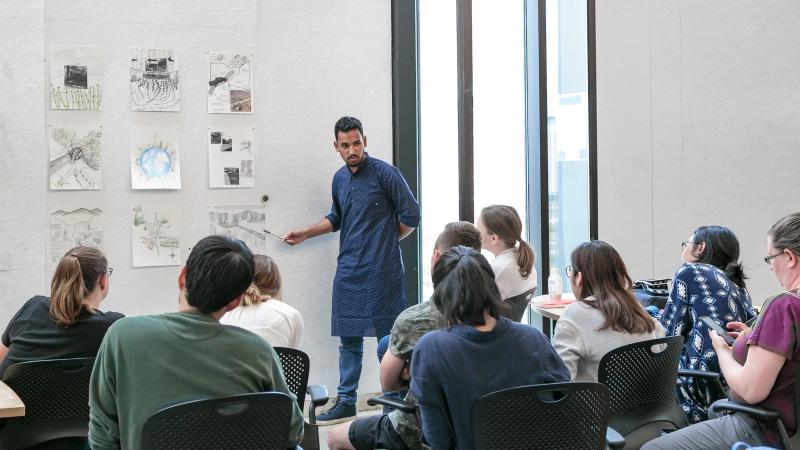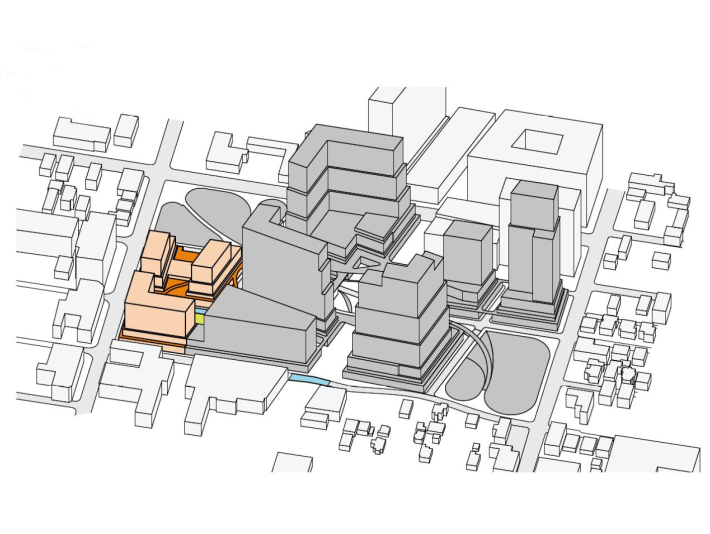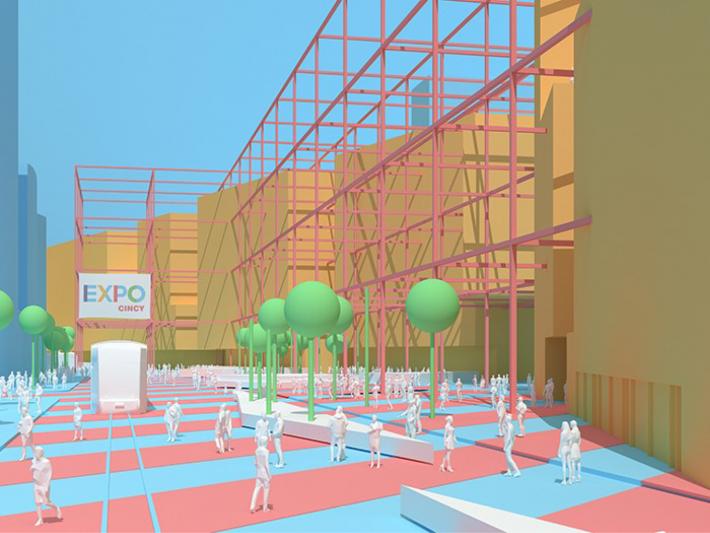Landscape Alum and Olmsted Scholar Raises Awareness of Climate Change
Harshat Verma discusses his path to landscape architecture, his work at Knowlton, and his plans to use technology to increase awareness of climate change.

Landscape Alum and Olmsted Scholar Raises Awareness of Climate Change
Harshat Verma (MLA ’21) was named the 2021 Graduate National Olmsted Scholar, one of the most prestigious awards in the nation given to a graduate student in the landscape architecture discipline. The Landscape Architecture Foundation Olmsted Program recognizes and supports students with exceptional leadership potential who are using ideas, influence, communication, service, and leadership to advance sustainable design and foster human and societal benefits.
We spoke with Harshat Verma to discuss his time in the landscape architecture program at the Knowlton School, his Hidden Habitats project, and what his plans are for his promising future.
First, congratulations on receiving the 2021 National Olmsted Scholar Award. Can you tell us about the path that led you to pursue a graduate degree in landscape architecture at Ohio State?
After completing an undergraduate degree in architecture, I spent a few years working at a socially-driven architecture firm in Mumbai in collaboration with landscape architects and ecologists. For a competition in Mumbai, we re-designed a nature park along an estuary and developed a regional strategy for flood mitigation. In the process, I was exposed to poor planning decisions and their effects on the health of the city. I studied the disrupted hydrological patterns, destruction of habitats, and displacement of marginalized communities. This experience sparked my interest in the world of landscape architecture and planning.
With a background in architecture and limited exposure to the field of landscape architecture, I wanted to find a school that would expose me to a wide range of concepts and help me become a well-rounded designer. I also wanted to be at a school where I could find a balance between research and design. My professors from my undergraduate school and the principal architect at the landscape firm I was interning at the time had spoken very highly of Ohio State. On researching further, I found that the faculty at the Knowlton School, who came from prestigious schools, had a diverse range of research interests that aligned with my educational goals. I was excited about course selection from different departments and the inter-departmental learning opportunities. The fact that the three disciplines of architecture, landscape architecture, and city and regional planning shared a space was very compelling as it would allow for a great collaborative environment.
Given the modest socioeconomic background that I come from, I believe that I would have had little chance to pursue my education abroad had it not been for the kind of scholarship I received from Ohio State. Besides Ohio State, I was also accepted into other high-ranking universities, but the financial support from the Knowlton School was beyond my expectations. I was offered a fully-funded scholarship in the first year, followed by a 20hr/week GA position for the next two years that would cover my tuition costs and provide a stipend. This helped cover my living expenses and allowed me to wholly focus my energy on my work.
During my school selection process, I had several conversations with then Landscape Architecture Graduate Studies Chair Jason Kentner. I could clearly see the school’s genuine interest in understanding my situation, concerns, and aspirations, which eventually helped me make my decision.
Your accomplishments have also been recognized within the Knowlton School; for example, you received the graduate first-year faculty prize for overall academic performance. What motivates you to continually raise the bar of your scholarship and innovative design work?
I think it is because of the super-humans I have met at Knowlton. My biggest motivation was the encouraging and supportive Knowlton community. Design programs often have a reputation of being competitive in an unhealthy way. At Knowlton, however, my classmates were incredible: not just were they warm and supportive, they were also inspiring. We instantly bonded like a family, and everyone was encouraging of each other’s work. Surrounded by classmates from different cultural and educational backgrounds, my educational journey was enhanced as it gave me fresh perspectives on how to think about design.
The faculty worked tirelessly toward improving our educational experience. Knowlton’s decision to keep the graduate batch small provided personal attention and mentoring, and helped me recognize my strengths, weaknesses, and potential. The faculty is also very accepting and responsive to our feedback. My friend and I were class representatives in my first year where we could take all our class issues to a committee and talk about anything without hesitation. We saw how quickly the feedback was turned into action which was extremely inspiring.
The other main factor was the financial support I got at the school. My family and I were filled with gratitude for the support, which pushed me to improve my work and effort.

The past year shifted how we teach and learn at the Knowlton School. Can you talk about how you adapted your part-time work as an associate in the Digital Fabrication Lab after the university transitioned to online teaching? Along this same line, how did your role as a graduate teaching assistant shift during the pandemic?
During the fall semester, it was unfortunate to see how the physical model culture in our school had to move to online presentations and modeling. This was of course due to the pandemic, and understandably necessary to reduce the traffic and in-person contact at the Fabrication Lab. It was still heartwarming to see many students try to use the Fab Lab and 3D printers in whatever capacity they could. During this time, I was also in the process of finalizing my research topic, where my inclination was towards making physical models relative to hydrological studies. The pandemic shifted my own focus toward digital models and tools.
In the spring semester, my work had changed to being a graduate associate for the advanced media seminar. Here I was helping make tutorials for different representation software used for landscape architecture. I also had to troubleshoot for students as a lot of issues came from accessing software, Knowlton computers, or answering software-related doubts. In a normal year and setting, a lot of this would have been peer-to-peer learning. Specifically for me, this turned out to be a blessing in disguise as in order to teach students I had to learn a fully new software called After Effects. This became the most important software for my last semester, without which I would not have been able to make the game trailer for my final research topic.
A number of your projects at Knowlton have involved collaborative efforts, notably your cross-disciplinary work on the ULI Hines Urban Design Competition. Can you expand on this experience and how it may inform how you approach design solutions in your future work?
The ULI competition was a pivotal moment during my time at Knowlton. We collaborated as a group of five students from the fields of landscape architecture, architecture, city and regional planning, and real estate. This was the exact experience I had hoped for when choosing Ohio State. We had mentors from each of these disciplines to help us in creating the final design entry. Our project received an honorable mention at the national level, and we were named the winners at the city level. Working rigorously for just two weeks, we were able to share and learn so much about each other’s disciplines and about the city. Since our site was in Miami-Dade, Florida, we wanted to explore issues relating to sea-level rise and saltwater intrusion and sought out inter-disciplinary strategies that could work at multiple levels and at various scales.
Seeing Miami through other lenses introduced me to real-world problems that are faced at grassroots levels. The complex issue of climate change left me with a lot of unanswered questions and concerns about the future of Miami-Dade. I was inspired to take this two-week research forward as my final year research project. I decided to take my learning from the competition project to study the effects of sea-level rise and saltwater intrusion, research tools that can help us comprehend the complexity of these issues, and additionally spread awareness so we can collectively make more informed decisions in the present and future.
Related News
You have explored the possibilities of world-building games—games where the objective is simply the exploration of an ever-evolving fantastical space—in your research at Knowlton. Can you provide some details about your project “Hidden Habitats,” and at what moments/courses during your MLA did gaming and landscape architecture begin to merge for you?
With the escalating frequency of extreme weather events due to climate change, there is an urgent necessity to increase awareness about climate change’s anticipated effects. We need to increase participation in this dialogue and expand the pool of those actively involved in the quest for viable, long-term adaptation and mitigation strategies. Scientists believe that there is currently a gap between scientific knowledge and public understanding, which is hindering us from having adaptive behaviors toward climate change. This gap is called an “adaptation deficit,” and gaming may offer one such tool that can try to bridge that divide.
Together with the help and guidance of faculty members from our school: Kristi Cheramie and Jake Boswell from landscape architecture, and Tijs Van Maasakkers from city and regional planning, I created a game proposal called "Hidden Habitats" that aspires to reduce this adaptation deficit. "Hidden Habitats" is a multi-player, multi-species, world-building game that simulates the experience of climate change across a range of urban ecosystems. The game invites players to enter its world in a range of avatars, including those of a mangrove, a human, or a crab and allows players to understand the impact of decision-making at various scales and the interconnectedness of different species. Through gameplay, players can see and test possible futures, empowering them to think critically about the state of their urban environments and make more informed decisions about the present and the future. This project connects design thinking around climate futures to the larger and highly engaged population of gamers.
As I mentioned earlier, I started my project by looking at Miami, and initially was invested in creating physical tools to test different landscape and resiliency strategies. With everything going online, I had to refocus my efforts a bit. I was still looking at experimentation and testing, but now I was looking at it from a digital perspective. In many ways, this shift helped reshape not just my project but my outlook as well. I was able to clearly see the outreach and engagement potential of digital tools.
My introduction to combining games and landscapes was through a studio I did with Justin Parscher in my second year. Our site was based in St. Louis, where we were trying to utilize vacant lots in the city for more productive use. To encourage residents in the neighborhood to take ownership of these landscapes, we created board games with a kit of parts like trees, paths, mounds, etc. Following the rules, they could create their own unique designs as a collaborative effort.
Cut to my final year spring semester, while playing the game SimCity (a city-building simulation game), I was able to see the power of games as a way of education and testing. In three sittings, I had made three different cities, each better than the last. I realized that this simulation game was a safe space where I did not hesitate to make mistakes. I was also able to see the implications of my design decisions in future scenarios. What I found flawed was that the game reinforced a finance-driven and anthropocentric view of the world. I began thinking about how games might challenge this view and become an educational and research tool towards climate change.
Media Gallery











I was motivated to create a game, but I lacked the skills for creating it. Fortunately, I took a seminar with Jake Boswell, where he taught us to use the gaming software Unity as a way to design landscapes. Through his three-day crash course, we were able to build a full gaming environment. This gave me a lot of encouragement to develop a game proposal. So rather than focus on building the whole game, I decided to create a trailer that would get the message across.
Broadening the conversation on climate change is an area in which you have expressed an interest. Expanding on your work in virtual spaces, how might emergent gaming technologies address and amplify this ever-increasing environmental concern?
Serious games is a category of games that sits at the intersection of learning, simulation, and gaming. They have proven to be effective tools for introducing and explaining complex issues of climate change to a large and diverse audience. Recently, the United Nations has developed games and mobile applications related to carbon emissions and climate change as a way of spreading awareness. Universities are using games in their classrooms to create enjoyable educational methods and spark curiosity. But these games still prioritize a single species. This focus, however, is not typical in the world of landscape architecture. As landscape architects, we are trained to view the world through the lens of insects, birds, trees, water, as well as human communities across the socio-economic spectrum. Games, I believe, also have the potential to share this perspective.
What I find most exciting are its outreach potential and associated impact. For instance, as of 2018, there were 24,700 registered landscape architects in the US. By contrast, 166 million people in the US play video games across multiple platforms, according to research conducted by the Entertainment Software Association (2018). This number has gone up to 214 million people in 2020! Imagine the possibilities of reaching out to such a huge number of people!
Growing up I admired the glitzy new urban centers that represented growth and development and despised the countryside with nature and animals running wild, and how that represented a lack of development. However, through the process of my last year, I realized that had I as a child played games that explained to me the unique role of all the different natural elements and other species, perhaps I would have thought differently.
Games like these can help teach children and adults the value and complexity of natural systems and even serve as a safe experimental tool for planners and designers. It can foster conversations about our values relative to climate change and help develop a new understanding and empathy for other systems—conversations that I hope can spark curiosity and enable individuals to question the decisions that build their surroundings and help reduce the adaptation deficit.
Can you provide a glimpse of the design work or areas of interest you hope to pursue in your professional career?
I am currently working on refining my gaming project. I want to workshop the proposal with other professionals and academics so I can eventually take it forward to game developers. Who's to say, it could be this game, a version of it, or a completely different game. But my aspiration is to combine landscape architecture with gaming and increase awareness of climate change. The scholarship I received from the Landscape Architecture Foundation will be instrumental in trying to turn this into a reality.
Eventually, I hope to run a practice that focuses on climate resiliency and ecocentric urban planning in India. I think urban spaces will constantly have to be redesigned to accommodate more people moving to cities and to adapt to the effects of climate change. This will create a lot of redesigning opportunities that can improve cities, but I worry it can also impact the habitats of other species. So, through my practice, I want to investigate sustainable practices that can maximize resilience and biodiversity.
I would also like to improve my understanding of climate justice. Often the brunt of extreme weather events is faced by the marginalized and underserved communities of society. I have witnessed this not only in India but also in America. I want to be able to improve my understanding of environmental and social justice and align my efforts toward rectifying this. Maybe tools like serious games can try and include these complex issues as well!



